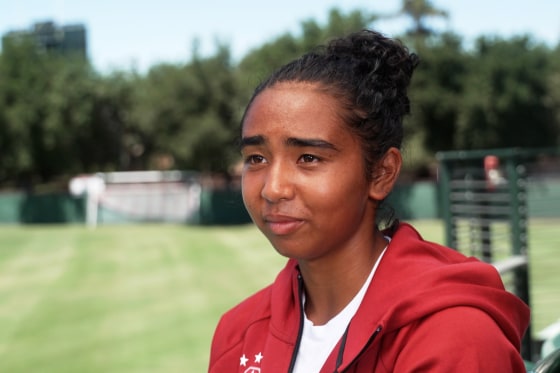For the past year, student-athletes have been faced with an unsettling question: How much are their lives about to change?
Last summer, 15 schools in the NCAA’s Football Bowl Subdivision realigned conferences, chasing lucrative media deals in what led to the demise of the Pac-12. Seemingly overnight, the 109-year-old conference of a dozen schools, with decades of rivalries, became a conference of only two. For some student-athletes, the switch meant their schools would play games across the country, leading to longer travel schedules, increased time away from campus and a more rigorous schedule. Athletes saw the move as a change they hadn’t entirely signed up for.
“The balance of practice, travel, school and having a social life is already hard enough,” Morgan Scott, a former member of the University of Oregon softball team, posted on X.
“Why add even more stress?”
Shannon Cunningham, a former member of the Arizona State University softball team, said the conference change shattered her dream of playing in the Pac-12.
“I had dreamt for so long to be a Pac-12 athlete, and to kind of see that go away because of football and because of money rights and television, it kind of was upsetting,” she said.
Cunningham now plays at San Diego State, a school much closer to home. She said she made the change primarily for reasons besides conference realignment, but the Pac-12’s disintegration was “the last blow.”
Realignment primarily benefits the Big Ten and the SEC, which will see increased revenue through media rights deals. The College Football Playoff contract with ESPN, worth $7.8 billion through the 2031 season, is one example of how much money is at play. The Big Ten and SEC are expected to share nearly 60% of this revenue according to The Associated Press, roughly $21 million per school, while Big 12 and ACC schools will take home around $12 to $13 million.
Nya Harrison, 21, a bioengineering major at Stanford University, and a member of the women’s soccer team, is feeling the effects of the Cardinal’s move from the Pac-12 to the ACC, a shift announced in September 2023. Harrison says sports like women’s soccer were an afterthought in the decision to change conferences.
“It was kind of like, football’s joining the ACC, basketball’s joining the ACC,” she told NBC News. “Any other team that was in the Pac-12, y’all are going to the ACC too.”
The closest schools to Stanford and Cal in the ACC are Notre Dame and Louisville — at least 2,200 miles away.
And on the other end, East Coast schools must fly to the West Coast for games. Wake Forest (approximately 2,800 miles one way) and Virginia Tech (approximately 2,700 miles one way) have to make the cross-country trek to Stanford for football this season.
Harrison said her team will be on the road for three long away trips during that quarter. She expressed concerns about fulfilling academic responsibilities while facing more time physically away from campus, particularly given Stanford’s rigorous academic schedule.
“That’s like three weeks of missing classes, missing midterms, missing lab assignments. Things like that are very crucial to, obviously, our class and our learning,” said Harrison.
Harrison also worries about the impact on athletes’ mental health, a growing concern in college athletics. A 2023 student-athlete health and wellness study conducted by the NCAA found that 67% of participants in women’s sports wished coaches and administrators talked more about mental wellness.
One coach in particular, University of Missouri football coach Eli Drinkwitz, made headlines last summer when he criticized realignment for not considering the impact on student-athletes.
“Did we count the cost for the student-athletes involved in this decision?” asked Drinkwitz. “We’re talking about a football decision, but what about softball and baseball who have to travel across the country?”
Karen Weaver, a former student-athlete and coach and now a member of the graduate faculty at the University of Pennsylvania, has spent her entire life immersed in the world of college athletics and has been working to change its landscape. She says big money is the sole reason for the change.
“What’s driving these mergers and acquisitions of schools into conferences is television revenue,” said Weaver, adding that “it is also being driven particularly by football,” which sees the largest returns in collegiate sports.
As for the long-term effect, Weaver says, disparities in budgets could lead to a divide within conferences. A school like Indiana, she notes, has an athletics budget of about $144 million, about half the size of a school like Ohio State’s. Both schools compete in the Big Ten.
While an increase in funds can mean new resources, like higher investments in academic support, improvements to dining facilities, or chartered flights, many student-athletes have voiced concerns about the potential mental and emotional downsides to the change.
For Harrison, the loss of teammate Katie Meyer to suicide made her more aware of her own mental health needs as a student-athlete.
“Dealing with that death, with such a close teammate, just struck me in a hard way and also made me self-reflect and realize how much of an impact being a student-athlete actually has on us,” Harrison said.
Harrison acknowledges that being a student-athlete is a choice.
“We are very much trained to be like, ‘You signed up for being a student-athlete.’ We know we signed up to be a student-athlete,” said Harrison. “We are student-athletes, but we’re also human.”
